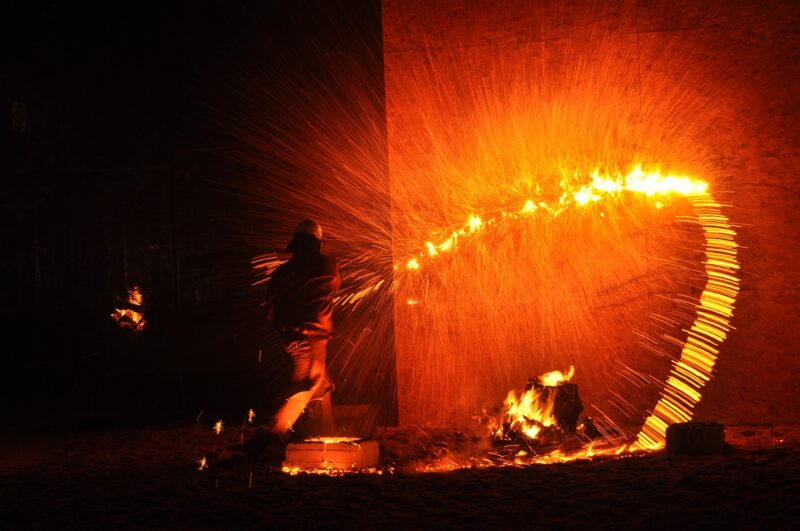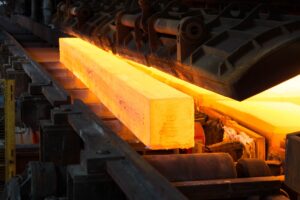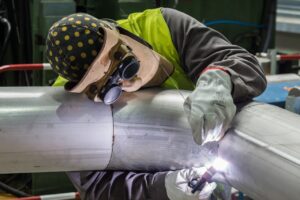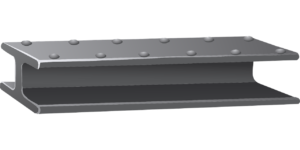Our Location
The melting points of various steel grades can help select the best fabrication technique and decide on the most practical application.
This guide will explore the melting points of different steel grades. Therefore, before you select steel for your next metal fabrication process, it is recommended that you read through this guide.

Table of Contents
ToggleA metal’s melting point is the temperature at which it changes from solid to liquid, existing in equilibrium between the two phases.
It is crucial to know the melting point of steel before selecting the appropriate steel grades for any project. The failure of components is the most critical factor to consider when choosing the correct grade for your application. If a metal liquefies at a temperature lower than its maximum range of application, the part will fail. It can lead to expensive repairs and safety hazards. Therefore, It is crucial to consider the specific steel’s melting point.

Steel is a type of alloy made up of iron and carbon. Its durability, resistance to corrosion, and high temperatures make it a commonly used metal in many industries. Different types and steel grades are available, resulting in varying steel melting points.
Carbon steel comprises 1-2% carbon and up to 1.65% manganese, with small amounts of silicon and copper. The melting point of carbon steel decreases as the carbon percentage increases. Other elements may also lower the melting point, ranging from 1425-1540°C.
Stainless steel is a commonly used steel alloy, especially for making kitchen cutlery. It is also referred to as inox steel and is made by adding 10.5% to 11% chromium by weight. There are five types of stainless steel: martensitic, austenitic, ferritic, duplex stainless steel, and precipitation-hardening martensitic. The stainless steel melting point is 1510°C (2750°F).
Mild steel contains more iron and less carbon than carbon steel, is available in different grades, and has a higher melting point due to its low carbon percentage—the melting point of mild steel ranges from 1350oC-1530oC.
Maraging steel has a higher percentage of carbon, nickel, cobalt, aluminum, molybdenum, and other elements. Its melting point is 1413°C.
Tool steel is primarily used for making tools due to its high hardness. It is a sturdier version of carbon and alloy steels, with a carbon percentage ranging from 0.7 to 1.4%. Other elements such as manganese, chrome, nickel, tungsten, molybdenum, phosphorous, and sulfur are added in varying proportions to create different types of tool steel. This type of steel has a melting point that ranges from 1400 to 1425°C (2550 to 2600°F).
Alloy steel comprises chromium, molybdenum, vanadium, silicon, manganese, nickel, and boron. The percentage of alloys present in the type of alloy steel determines the melting point, which ranges from 1432°C to 1415°C.

The following factors affect the melting point of steel:
Thermal expansion can be a significant factor affecting a metal’s melting point. This expansion decreases bonding forces, which can cause the metal to change its state. Applying pressure to the object can reduce the expansion rate, both volumetrically and thermally, thereby increasing the melting point.
Steel is composed of a dense structure held together by a metallic bond. These bonds have strong attraction forces, which can vary in strength depending on the type of steel. The strength of these attraction forces also influences the melting point of steel.
In steel, anything other than iron and carbon is considered an impurity. The melting point of the steel depends on the number of impurities present. If there are more impurities, the steel will melt slower. Conversely, the melting point increases as the number of impurities decreases. The presence of contaminants increases the melting point of steel.

A metal’s melting point depends on its composition, atomic structure, density, and thermal conductivity.
Steel is a mixture of iron and carbon, and its properties vary depending on the other elements added to it. This variation results in different melting points ranging from 1370°C to 1520°C. On the other hand, copper is a pure, soft metal with excellent thermal conductivity. Its high conductivity causes a lower melting point, which is 1,085°C.
Brass is not as popular as other steel variants, due to its composition of materials like zinc and copper. It is typically used in applications that require corrosion resistance, low friction, and good electrical conductivity. The melting point of brass varies depending on its composition, but it generally ranges from 900 to 940 degrees Celsius (1652 to 1724 degrees Fahrenheit). Steel is better suited to higher temperatures than brass.
Bronze is a mixture that mainly consists of copper. Other elements such as zinc, tin, aluminum, manganese, or nickel are added. Due to its high copper content, its melting point is lower than steel’s. On the other hand, steel contains iron and similar elements, giving it a higher melting point. Steel has a melting point of 1370°C to 1520°C, while brass has a melting point ranging from 850°C to 1000°C.
Tinplate, also known as tinplated steel, is a steel that has been coated with a layer of tin to enhance its appearance and protect it from corrosion. The melting point of tinplated steel is similar to that of regular steel. However, the tin coating on tinplated steel has a lower melting point of about 232°C (450°F). It means that while the steel core remains solid at high temperatures, the tin coating may melt or deform, affecting the overall performance of tinplated steel in certain applications.
Aluminum is a lightweight metal renowned for its outstanding corrosion resistance and high thermal conductivity. It changes its shape when it is subjected to heat sources between 660°C and 660.5°C (1220 to 1221 degrees Fahrenheit), much lower than steel’s temperature.
Titanium is a highly durable metal with approximately half the iron density. One of its unique properties is its low thermal conductivity, which makes it ideal for applications that require heat resistance. Despite being less dense than steel, titanium has a higher melting point than steel due to its low thermal conductivity. While steel’s melting point ranges from 1370°C to 1520°C, titanium’s melting point is between 1660°C to 1680°C.
Iron is the main ingredient in steel. The more iron in the steel, the higher the melting point. However, steel also contains carbon and sometimes other elements. The alloy’s melting point usually decreases if more trace elements are present in the steel. Iron is a very dense material and has low thermal conductivity. The melting point of iron is 1538°C, which is higher than most steel types, ranging from 1370°C to 1520°C.
Steel is a metallic material, while glass is an amorphous solid made from silica, soda, and lime. Glass has a lower melting point than steel, which varies depending on the type of glass. Soda-lime glass, the most common type, has a melting point of around 600-800°C. Borosilicate glass has a higher melting point of around 800-850°C. Both types of glass are more susceptible to melting or deforming when exposed to high temperatures than steel.

There are a few ways to increase the melting point of steel and make it more heat-resistant. These methods include:
1. Increase the pressure on the steel. Higher pressure leads to a higher melting point. Pressure helps to increase the melting point of steel.
2. Reduce the percentage of carbon. The higher the percentage of carbon in steel, the lower its melting point. When purchasing steel in high-temperature settings, choose steel with a lower carbon percentage.
3. Add alloys that can increase the melting point. Chromium and molybdenum can be added to steel to raise its melting point.
4. Use a limited number of elements. Although different elements can be added to steel for their various benefits, the greater the number of alloys, the lower the melting point. Steel with fewer elements has a higher melting point.
Steel is a strong, long-lasting metal with a high level of resistance to corrosion. It has a high melting point, which means it can withstand high temperatures if they do not exceed its melting point. Before purchasing or seeking clarification from the manufacturers, it is essential to understand the melting point of steel.

